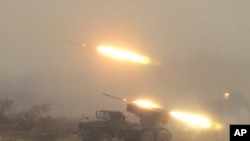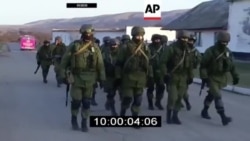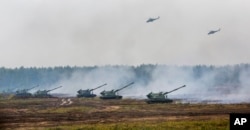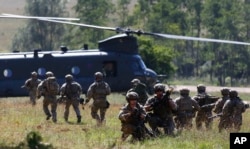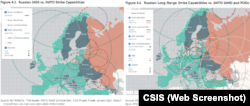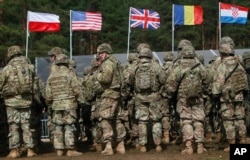In an RT op-ed, Bryan MacDonald, a journalist based in Russia, dismissed a top U.S. State Department official’s claim regarding Russia’s conventional military threat to the West, calling it “clear disinformation.”
MacDonald was referring to statements by Brian Hook, senior policy advisor to U.S. Secretary of State Rex Tillerson, during the Sixth Annual Transatlantic Forum on Russia held at the Washington-based Center for Strategic and International Studies on November 17.
Highlighting Russia’s support to rebels in eastern Ukraine, annexation of Crimea, and war with Georgia in 2008, Hook stated: “The threat to collective security [of the West] posed by Russia is clear, and we on both sides of the Atlantic cannot ignore it.”
He said Russia’s actions violated the U.N. Charter and the Helsinki Final Act, adding that, “as in the past, the threat runs from the Baltic to the Black Sea.”
Hook said the “conventional threat” from Russia is “real” and the "military arrangement of forces in Europe favors Russia.” He pointed to Russia’s military capabilities demonstrated during the Zapad 2017 drills with ally Belarus and its development of a nuclear-capable cruise missile in violation of the Intermediate-Range Nuclear Forces Treaty.
Quoting another RT piece examining Hook’s statements, MacDonald portrayed the official’s claims as “absolute balderdash,” concluding that “a claim that Russia’s military strength eclipses that of European Union states is especially ludicrous... Thus, it [Russia] is not stronger than the European Union, by any measure, and the State Department’s Hook is spreading clear disinformation. All to serve an agenda that has nothing to do with Europe’s security.”
MacDonald’s op-ed argued that because Russia’s GDP and military spending are lower than those of the U.S. and select EU states, Russia is not the threat Hook makes it out to be. However, MacDonald’s analysis is based on raw numbers rather than a quantitative and qualitative assessment of capabilities. It disregards cost differentials associated with fielding military forces. It does not assess the EU states’ ability to conduct effective operations individually and in concert. And it ignores Russia’s intentions and military capabilities as threat factors.
The fact that EU members have more servicemen and collectively spend more money on defense than Russia does not necessarily translate into effective national or joint military capabilities. And Russia has shown it has the capability to conduct effective offensive operations in Europe.
Analysts David Shlapak and Michael Johnson argued in a piece examining Russia’s and NATO’s military capabilities that “[w]ithout a plan, without adequate logistics, without robust command and control, a better-prepared adversary would still overwhelm NATO.”
As Polygraph.info has noted: “When the Kremlin focuses selectively on U.S. troops, it fails to mention that the defense preparedness of some European states is suspect at best amid stagnant or declining defense budgets across the continent since the collapse of the USSR in 1991.” This is despite a recent push for NATO member states to increase budget contributions given the financial burden on the U.S. and need to boost allied capabilities.
Steven Pifer, an expert specializing in arms control and Russia at the Brookings Institution and former U.S. ambassador to Ukraine, says that “a major modernization program, an increased number of military exercises, and more assertive actions by Russian military aircraft near NATO airspace” underscore Russia’s conventional military threat to the West, which “cannot ignore this.”
He adds: “The threat of Russia attacking a NATO country – most scenarios focus on the Baltic states – is very small. But five years ago, most analysts would have put that prospect at zero. Kremlin actions and rhetoric have changed how the West views Russia militarily.”
Russia enjoys a more favorable posture and capabilities in eastern Europe, prompting initiatives by the EU and NATO to bolster their members’ security.
According to a 2017 report by the Center for Strategic and International Studies comparing the U.S. and Russian armies, “Russia has either equaled or surpassed certain U.S. capabilities in A2/A2, ground combat, and non-kinetic operations.” However, the U.S. Army still enjoys “an overall qualitative advantage over Russian and similar near-peer forces,” despite the narrowing gap in capabilities.
In the Baltic area, Pifer notes, Russia could muster more forces in the event of hostilities: “While NATO forces are deployed in each of the Baltic states, those provide tripwires and would require major reinforcement to be able to stop a Russian attack.”
Justin Bronk, a research fellow at the Royal United Services Institute, shares this assessment: “Russia could quickly mass forces sufficient to overwhelm local NATO troops and it would take time for NATO to build up sufficient reserve forces to dislodge them.”
The U.S. special representative for Ukraine, Kurt Volker, stated in July that “there are more Russian tanks in there [Ukraine] than [all tanks] in Western Europe combined.”
In testimony before the U.S. Senate Armed Services Committee in April 2016, U.S. Army Chief of Staff General Mark Milley said the U.S. military is “technically outranged, outgunned” by Russia’s military in Europe.
Russia, for its part, has blamed the West for the so-called “color revolutions” that removed pro-Moscow regimes in Kyrgyzstan, Georgia, and Ukraine in 2003-5.
It has also accused the West of breaking a promise not to expand NATO to Russia’s borders.
In August, Russia’s Ambassador to NATO Aleksandr Grushko said the political situation in Europe was “seriously worsening” amid a “pump-up of arms and armor by the NATO countries on the eastern flank” of Russia on the “contrived pretense of a Russian threat.”
A year earlier, Russia announced it would create three new divisions to counter four battalions NATO intended to deploy to Poland and the ex-Soviet Baltic states.
“The political situation along the western border of the country remains unstable,” Defense Minister Sergei Shoigu said a few months later, noting NATO’s increased military potential.
Russia has also denounced Washington’s plans to deploy a ballistic missile defense system in eastern Europe aimed at protecting European allies from Iran’s missiles, portraying the declared goal as a cover to undermine Russia’s strategic deterrent.
And Russia views its actions in Georgia and Ukraine as necessary to protect its own citizens, minorities, and the Russian-speaking population, as well as to ensure regional security.
Since 2014, Russia has viewed Ukraine’s Western-backed government as illegitimate after popular protests in Kyiv led to the ouster of Victor Yanukovych as president. Under Russian pressure, Yanukovych had refused to sign an association agreement with the EU.
The concerns of the parties aside, the balance of forces in Europe and Moscow’s recent actions clearly show that Russia poses a conventional military threat to Europe.




